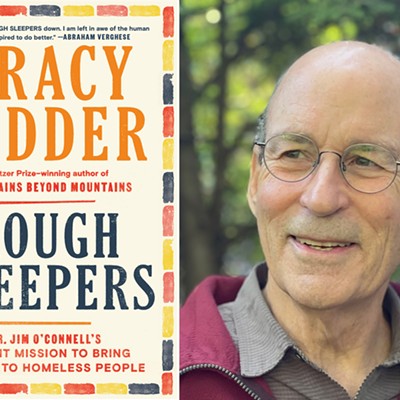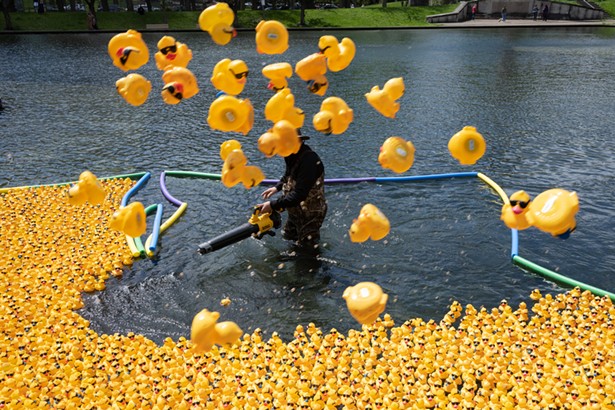Like author David Maraniss, we come to praise Roberto Clemente. But still: Doesn't it seem as though, in the past half-century's pantheon of Pittsburgh sports heroes, Clemente stands alone, more in mere solitude than in anything else? True, we named a bridge after the guy, and his statue's at the end of it. But official tributes, and even generally conferred auras of saintliness, are one thing. In the heart Pittsburgh wears on its tavern walls, we are more smitten with the stove-in grimace of Jack Lambert, the frozen music of Lemieux, even Mazeroski, right hand raised high, than with the man this city at first called "Bob Clemente."
Searching for the reasons is one way to read Clemente: The Passion and Grace of Baseball's Last Hero, Maraniss' worthy new biography. For instance, if it's easy to forget the city (and the nation) where Clemente arrived in 1955, Maraniss, a Washington Post associate editor and Pulitzer-winning journalist, reminds us forcefully. Clemente grew up dark-skinned in a Puerto Rico where race meant little; his major-league contract brought him to spring training in the Jim Crow South ... where whites-only hotels and restaurants for players lasted well into the 1960s ... and to Pittsburgh, which had introduced its first black Pirate only a year earlier. Yet despite living happily in the Hill District, Clemente was never really part of Pittsburgh's African-American community, either, at least partly because English was his second language.
Likewise, sportswriters ... excepting the Pittsburgh Courier's ... often stereotyped the hard-hitting, defensively magnificent right-fielder as a Latino showboat (or malingerer), all while smirkily attempting to transcribe his accent ("I Get Heet, I Feel Good," read a Post-Gazette headline after the 1961 All-Star game). And Clemente, touchy as a spider's web, didn't help, interpreting innocuous questions and comments as aspersions upon his abilities or character.
Clemente's demeanor ... he so often seemed aloof, regal, apart ... is typically chalked up to pride. Maraniss digs deeper. While Clemente mellowed with age, even after he was widely admired he motivated himself by claiming he was misunderstood and underappreciated.
Maraniss, moreover, finds a man driven, even tortured, not only by insomnia and chronic back pain, but by premonitions of his own death and the fear he wasn't doing enough as a player and humanitarian. When Clemente ran his churning run, Maraniss writes, "it seemed not so much that he was trying to get to a base as to escape from some unspeakable phantasmal terror."
Maraniss occasionally succumbs to the hardball fan's weakness for endless statistics. And in his chapter on the 1960 World Series, he loses his thread: It's a rousing recitation, but so detailed that the nominal protagonist is sidelined. (Yet even that's somehow appropriate: Diffident Clemente stood apart on this Bucs squad of quotable good old boys.) Maraniss even spends more pages on the '60 Series than on the equally exciting '71 Series, in which Clemente reached his on-field apotheosis, at age 37 hitting .414 and earning the Series MVP.
On the other hand, Maraniss concisely and vividly explains why Clemente (the author's own favorite player) became a virtual demi-god in Latin America, even before becoming the first Latino voted into baseball's Hall of Fame. And Maraniss clears the bases with his sobering and smartly reported account of the catastrophic 1972 earthquake in Nicaragua over which Clemente, in a cargo plane loaded with relief supplies, lost his life. Maraniss skillfully weaves together the selfish flight from Managua of billionaire head-case Howard Hughes, the reactions of President Nixon and U.S.-backed strongman Anastasio Somoza ... whose troops profiteered off relief efforts ... and Clemente's rash decision to undertake his own mission. And then there is the maddening history of the rattletrap airplane itself, its bad-news owner, and the lax enforcement agencies which permitted an unqualified crew to take an overburdened aircraft over open ocean.
A final touch brings the story back to Pittsburgh, and Clemente's place here. Dec. 23, 1972, was the day of both the quake and an event most Pittsburghers heeded with more alacrity: Franco Harris' Immaculate Reception. It was the day, Maraniss observes, that pro football decisively and permanently supplanted baseball as Pittsburgh's sport of choice. And its absurd juxtaposition with the quake, and with Clemente's deeply felt need to alleviate the natural disaster's horror, tolls out the vast space between him and the "hometown" fans he loved.
Of course, as Maraniss notes, the Three Rivers Stadium stands were three-quarters empty even on the night Clemente cracked his 3,000th hit; Pittsburgh had long been a football town anyway. We make it so: We are constantly recasting the Steelers in our own romanticized image, as gritty, lunch-pail guys who just happen to make $6 million a year.
But Clemente, a man of humble origins who played before sports salaries metastasized, was a fan favorite without ever reflecting Pittsburgh's idea of itself. In time, as Maraniss tells us, Pittsburghers not only appreciated his athletic beauty, but also learned a few words of Spanish. They learned to call their right-fielder "Roberto." In becoming a hero, Clemente made Pittsburgh a little more like him.














